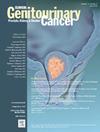Estimating the Impact of Adjuvant Treatment With Nivolumab on Long-Term Survivorship Rates Compared With Surveillance in Muscle Invasive Urothelial Carcinoma: Mixture Cure Modeling Analyses of Disease-Free Survival From the Phase 3 CheckMate 274 Trial
IF 2.7
3区 医学
Q3 ONCOLOGY
引用次数: 0
Abstract
Background
Curative potential of adjuvant nivolumab was compared with radical resection only among patients at high risk of recurrence following radical surgery of muscle-invasive urothelial carcinoma (MIUC).
Methods
Using patient-level disease-free survival (DFS) data from CheckMate 274 (n = 709, minimum follow-up, 31.6 months), we applied mixture cure models (MCMs) to the adjuvant nivolumab (NIVO) and placebo (PBO) arms of the intention-to-treat (ITT) population and tumor PD-L1 expression ≥1% subpopulation. DFS was derived for hypothetical “cured” and “uncured” subgroups. DFS for the cured subgroup was estimated using WHO background mortality rates matched to trial demographic characteristics. Uncured DFS was modeled using parametric distributions and characterized with cure fractions by maximum-likelihood methods. Model selection considered clinical plausibility, visual comparisons of model fit, and goodness-of-fit statistics.
Results
MCM analysis demonstrated that almost all uncured patients experience recurrence or death within 5 years. Clinically plausible models estimated higher cure fractions in tumor PD-L1 ≥1% subgroup for patients treated with NIVO (PD-L1 ≥1%: 59.1%-61.0% vs ITT: 43.1%-45.1%), and highly similar cure fractions for patients receiving PBO irrespective of their PD-L1 expression (PD-L1 ≥1%: 35.9%-36.4% vs ITT: 36.4%-37.0%). Projected 10-year mean DFS was 4.38 to 4.47 years for NIVO and 3.61 to 3.64 years for PBO in the ITT population, and 5.54 to 5.65 years for NIVO and 3.54 to 3.57 years for PBO in the PD-L1 ≥1% subpopulation.
Conclusions
Adjuvant NIVO for high-risk MIUC was associated with a higher cure fraction than PBO in the ITT and PD-L1 ≥1% populations. Results align with reported survival from the trial and highlight clinical outcomes of interest. CheckMate 274 ClinicalTrials.gov identifier, NCT02632409.
与监测相比,估计Nivolumab辅助治疗对肌肉侵袭性尿路上皮癌长期生存率的影响:CheckMate 274试验3期无病生存的混合治愈模型分析
研究背景:在肌肉侵袭性尿路上皮癌(MIUC)根治性手术后复发风险高的患者中,对辅助nivolumab的治疗潜力与仅根治性切除进行了比较。方法使用CheckMate 274 (n = 709,最短随访31.6个月)的患者水平无病生存(DFS)数据,我们将混合治愈模型(MCMs)应用于意向治疗(ITT)人群和肿瘤PD-L1表达≥1%亚人群的辅助尼沃单抗(NIVO)和安慰剂(PBO)组。DFS是根据假设的“治愈”和“未治愈”亚组得出的。治愈亚组的DFS使用与试验人口统计学特征相匹配的世卫组织背景死亡率进行估计。未固化DFS采用参数分布建模,并采用最大似然方法用固化分数表征。模型选择考虑了临床合理性、模型拟合的目视比较和拟合优度统计。结果smcm分析显示,几乎所有未治愈的患者在5年内复发或死亡。临床可信的模型估计,NIVO治疗患者的肿瘤PD-L1≥1%亚组的治愈率更高(PD-L1≥1%:59.1%-61.0%,ITT: 43.1%-45.1%), PBO患者的治愈率非常相似,无论其PD-L1表达如何(PD-L1≥1%:35.9%-36.4%,ITT: 36.4%-37.0%)。ITT人群中NIVO的10年平均DFS为4.38 ~ 4.47年,PBO为3.61 ~ 3.64年,PD-L1≥1%亚群中NIVO的10年平均DFS为5.54 ~ 5.65年,PBO为3.54 ~ 3.57年。结论在ITT和PD-L1≥1%人群中,辅助NIVO治疗高危MIUC的治愈率高于PBO。结果与试验报告的生存率一致,并突出了感兴趣的临床结果。CheckMate 274 ClinicalTrials.gov识别码,NCT02632409。
本文章由计算机程序翻译,如有差异,请以英文原文为准。
求助全文
约1分钟内获得全文
求助全文
来源期刊

Clinical genitourinary cancer
医学-泌尿学与肾脏学
CiteScore
5.20
自引率
6.20%
发文量
201
审稿时长
54 days
期刊介绍:
Clinical Genitourinary Cancer is a peer-reviewed journal that publishes original articles describing various aspects of clinical and translational research in genitourinary cancers. Clinical Genitourinary Cancer is devoted to articles on detection, diagnosis, prevention, and treatment of genitourinary cancers. The main emphasis is on recent scientific developments in all areas related to genitourinary malignancies. Specific areas of interest include clinical research and mechanistic approaches; drug sensitivity and resistance; gene and antisense therapy; pathology, markers, and prognostic indicators; chemoprevention strategies; multimodality therapy; and integration of various approaches.
 求助内容:
求助内容: 应助结果提醒方式:
应助结果提醒方式:


